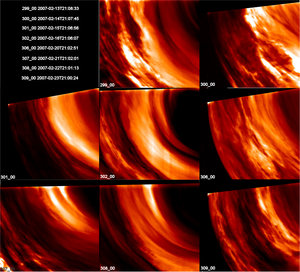Accept all cookies Accept only essential cookies See our Cookie Notice

About ESA
The European Space Agency (ESA) is Europe’s gateway to space. Its mission is to shape the development of Europe’s space capability and ensure that investment in space continues to deliver benefits to the citizens of Europe and the world.
Highlights
ESA - United space in Europe
This is ESA ESA facts Member States & Cooperating States Funding Director General Top management For Member State Delegations European vision European Space Policy ESA & EU Space Councils Responsibility & Sustainability Annual Report Calendar of meetings Corporate newsEstablishments & sites
ESA Headquarters ESA ESTEC ESA ESOC ESA ESRIN ESA EAC ESA ESAC Europe's Spaceport ESA ESEC ESA ECSAT Brussels Office Washington OfficeWorking with ESA
Business with ESA ESA Commercialisation Gateway Law at ESA Careers Cyber resilience at ESA IT at ESA Newsroom Partnerships Merchandising Licence Education Open Space Innovation Platform Integrity and Reporting Administrative Tribunal Health and SafetyMore about ESA
History ESA Historical Archives Exhibitions Publications Art & Culture ESA Merchandise Kids Diversity ESA Brand Centre ESA ChampionsLatest
Space in Member States
Find out more about space activities in our 23 Member States, and understand how ESA works together with their national agencies, institutions and organisations.
Science & Exploration
Exploring our Solar System and unlocking the secrets of the Universe
Go to topicAstronauts
Missions
Juice Euclid Webb Solar Orbiter BepiColombo Gaia ExoMars Cheops Exoplanet missions More missionsActivities
International Space Station Orion service module Gateway Concordia Caves & Pangaea BenefitsLatest
Space Safety
Protecting life and infrastructure on Earth and in orbit
Go to topicAsteroids
Asteroids and Planetary Defence Asteroid danger explained Flyeye telescope: asteroid detection Hera mission: asteroid deflection Near-Earth Object Coordination CentreSpace junk
About space debris Space debris by the numbers Space Environment Report In space refuelling, refurbishing and removingSafety from space
Clean Space ecodesign Zero Debris Technologies Space for Earth Supporting Sustainable DevelopmentLatest
Applications
Using space to benefit citizens and meet future challenges on Earth
Go to topicObserving the Earth
Observing the Earth Future EO Copernicus Meteorology Space for our climate Satellite missionsCommercialisation
ESA Commercialisation Gateway Open Space Innovation Platform Business Incubation ESA Space SolutionsLatest
Enabling & Support
Making space accessible and developing the technologies for the future
Go to topicBuilding missions
Space Engineering and Technology Test centre Laboratories Concurrent Design Facility Preparing for the future Shaping the Future Discovery and Preparation Advanced Concepts TeamSpace transportation
Space Transportation Ariane Vega Space Rider Future space transportation Boost! Europe's Spaceport Launches from Europe's Spaceport from 2012Latest

Cloudy Venus
Thank you for liking
You have already liked this page, you can only like it once!
Our sister planet Venus is a dynamic and unusual place. Strong winds swirl around the planet, dragging thick layers of cloud with them as they go. These fierce winds move so speedily that they display ‘super-rotation’: Earth’s can move at up to a fifth of our planet’s rotation speed, but winds on Venus can travel up to 60 times faster than the planet.
Observations from ESA’s Venus Express, which orbited Venus from 2006 to 2014, and other international spacecraft have probed deeper into this wind and cloud in past years, and uncovered some peculiar behaviour.
The side of the planet facing away from the Sun is somewhat more mysterious than the other side, but what we do know shows it to be quite different, with never-before-seen cloud types, shapes and dynamics – some of which appear to be connected to features on the surface below.
Super-rotation appears to behave more chaotically on the night side than the day side, but climate modellers remain unsure why. Night-side clouds also create different patterns and shapes than those found elsewhere – large, wavy, patchy irregular and filament-like patterns – and are dominated by mysterious ‘stationary waves’. These waves rise up within the atmosphere, do not move with the planet’s rotation, and appear to be concentrated above steep and higher-altitude regions of the surface, suggesting that Venus’ topography may well affect what happens in the cloud layers way up above.
These three images from the visible and infrared camera on Venus Express show these cloud features in detail: stationary waves (left), dynamical instabilities (middle) and mysterious filaments (right).
Venus Express was launched in 2005 and began orbiting Venus in 2006; the mission ended in December 2014. This image is based on the news item Venus' mysterious night side revealed, published in 2017.
-
CREDIT
ESA, NASA, J. Peralta & R. Hueso -
LICENCE
ESA Standard Licence

Venus’ fickle atmosphere (colour image)

Close-up view over Venus south polar vortex

Variable clouds and hazes at Venus

Ultraviolet view of cloud structures at Venus















 Germany
Germany
 Austria
Austria
 Belgium
Belgium
 Denmark
Denmark
 Spain
Spain
 Estonia
Estonia
 Finland
Finland
 France
France
 Greece
Greece
 Hungary
Hungary
 Ireland
Ireland
 Italy
Italy
 Luxembourg
Luxembourg
 Norway
Norway
 The Netherlands
The Netherlands
 Poland
Poland
 Portugal
Portugal
 Czechia
Czechia
 Romania
Romania
 United Kingdom
United Kingdom
 Slovenia
Slovenia
 Sweden
Sweden
 Switzerland
Switzerland
























